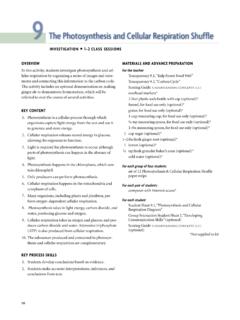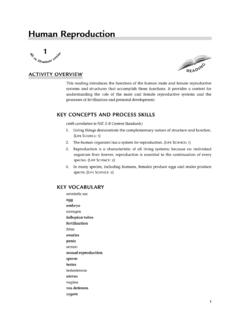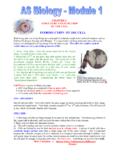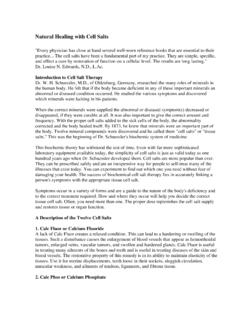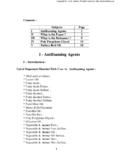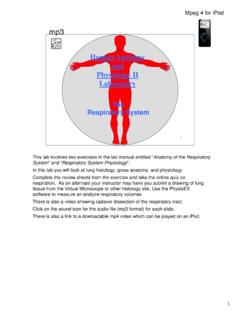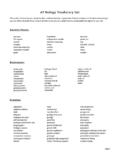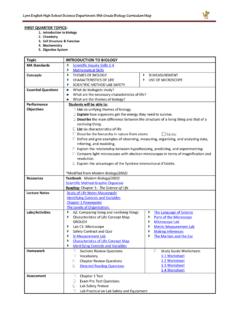Transcription of Cell Differentiation and Gene Expression - …
1 576 17 Cell Differentiation and gene ExpressionACTIVITY OVERVIEWS tudents investigate gene Expression as it relates to cell Differentiation in four human cell types. They consider how various physiological events affect gene Expression in each of the four cell types. KEY C OnTE nT 1. The Expression of specific genes regulates cell differen tiation and cell functions. 2. Somatic cells in an individual organism have the same genome, but selectively express the genes for production of characteristic proteins. 3. The proteins a cell produces determine that cell s PROCEss sKIlls 1. Students conduct investigations. 2. Students develop conclusions based on evidence. MATERIAls And AdVAnCE PREPARATIOn For the teacher transparency of Student Sheet , Genetics Case Study Comparison For each group of four students set of 14 Cellular Event CardsFor each pair of students 3 colored pencils (blue, brown, and orange)For each student model of human chromosome 2 model of human chromosome 11 4 silver binder clips 7 red paper clips 7 green paper clips Student Sheet , Chromosome Map Student Sheet , Genetics Case Study Summary, from Activity 2 3 sticky notesTEAChIng suMMARYG etting Started Elicit students ideas about the genetic makeup of different cells in a multicellular organism.
2 Doing the Activity Students investigate gene Expression . Follow-up The class discusses gene Expression and gene regulation. (LITERACY) Students read a case study about terminator genes. BACKgROund InfORMATIOnGene ExpressionGene Expression is the process in which the information stored in DNA is used to produce a functional gene product. gene products are either proteins or noncoding RNAs, such as tRNA and rRNA, which play essential roles in protein syn thesis, but do not code for proteins. gene Expression is regu lated throughout the lifespan of an individual cell to control the cell s functions, such as its metabolic activity. gene Expression plays a critical role in the morphological changes that take place in a developing embryo and fetus and in the Differentiation of stem cells to form specialized Expression of protein coding genes is regulated at a number of steps, including 1) transcription of DNA to form RNA, 2) processing of the RNA product, 3) translation mRNA to produce protein, and 4) post translational modifi cation of the protein product.
3 This activity introduces stu dents to controls that interact directly with DNA to regulate the transcription of genes into mRNA by RNA polymerase, the enzyme that links ribonucleotides together to form RNA. Transcription is regulated by changes in the DNA and associ ated histone proteins that affect the condensation of the DNA and by proteins called transcription factors. These transcription factors serve as activators or repressors of tran scription. Activators increase the binding of RNA poly merase to the promoter of a gene , thus increasing the rate of transcription. Repressors bind at or near the promoter and interfere with the activity of RNA a n d m o d e l i n g 1 2 c l a s s s e s s i o n s577 CEll Differentiation And gene Expression ACTIVITY 17In prokaryotes, usually clusters of genes are under the con trol of one promoter that is adjacent to the gene sequences.
4 The promoter is a stretch of DNA where RNA polymerase first binds before the initiation of transcription. These clus ters of genes adjacent to a single promoter are called operons. The best known example of this is the lactose operon of , made up of three genes involved in lactose metabolism. The operon includes the promoter, the three protein coding genes, and a regulatory sequence called an operator. This arrangement allows the three genes to be turned on or turned off at the same eukaryotes, the regulation of gene Expression is more complex. Genes are generally regulated individually rather than in operons. Each gene has its own promoter and several regulatory sequences called enhancers, some of which may be distant from the gene and its promoter.
5 Multiple activa tors, co activators, and repressors might be involved in the regulation of a eukaryotic gene by affecting the condensation of the DNA, by interacting with the promoter, or by inter acting with regulatory sequences. This complex regulation allows the rate of transcription to be modulated as And glOBAl IssuEs/BIOlOg Y gEnETICs578gETTIng sTARTEd 1 Discuss the variety of human cells and the role of proteins in cel lular functions. Ask the class to sug gest several types of cells that can be found in a human. Record students responses on the board or chart paper. If students studied the Science and Global Issues Cell Biology: World Health unit, they should be able to name at least the following: red and white blood cells , skin cells , nerve cells , muscle cells , and liver cells .
6 Next, ask the class to list simi larities between these cells . They should be able to name a variety of organelles contained in each, as well as the nucleus and genetic material. Emphasize that every somatic cell in a human contains the same chromo somes with the same set of genes, but the phenotype Expression of the genes differs from one type of cell to another. Remind students that in the Cell Biology unit they explored the functions of proteins as the doers in the cell. Point out that even though every cell contains the same genome, each cell only needs to make those proteins it requires for doing its job in the body. For example, only certain cells in the mouth make salivary enzymes, and no other cell in the body needs to make those.
7 Explain that in this activity, students will investigate how the types and amounts of proteins produced by a cell are regulated. 376 Although the two humancells shown have the same genes in their nuclei, they are specialized to make dif-ferent proteins. The skeletalmuscle cells , top, are spe-cialized for voluntary mus-cle movement, while the thyroid cell, left, makes large amounts of thyroid hormone. 1 7 Cell Differentiation and gene ExpressionIN MOST HUMAN cells , the nucleus contains a full set of 23 pairs of chromo-somes, which carry 20,000 25,000 genes. These genes are identical from cell tocell. In Activity 16, Protein Synthesis: Transcription and Translation, you learned that genes are transcribed to produce RNA, and that this RNA is in turn translatedto produce proteins.
8 If all cells in the same organism have the same genes, why don t they all make the same proteins?Some proteins are made by almost every cell because they are needed for basic cellfunctions. Other proteins are made by only one type of cell or small groups of cells . Only white blood cells , for example, make antibodies, the proteins that helpthe body fi ght infections. Each of the more than 220 kinds of specialized cells inthe human body makes a characteristic group of proteins. 1579 CEll Differentiation And gene Expression ACTIVITY 17dOIng ThE ACTIVITY 2 The karyotype image in the Stu dent Book shows the 23 pairs of chromosomes in a human cell. In this activity, students will only work with one chromosome from pair 2 and one chromosome from pair 11, which are sufficient for showing the principles of gene regulation.
9 377In each cell, only some of the genes are active, activity of genesin a cell is called gene Expression . In this activity, you will explore how some genes are turned on and off by molecules called transcription factors. These moleculescontrol the transcription of DNA into does the same set of genes direct the activities of 220 human cell types? MATERIALS: FOR EACH GROUPFOR EACH GROUP FOR EACH STUDENTFOR EACH STUDENTFOR EACH STUDENT model of human chromosome 2model of human chromosome 114 silver binder clips p7 red paper clipspp p7 green paper clipsg pp pStudent Sheet , ChromosomeStudent Sheet , Chromosome Map Student Sheet , Genetics CaseStudent Sheet , Genetics Case Study Comparison, from Activity 23 sticky notesyset of 14 Cellular Event CardsFOR EACH PAIR OR STUDENTSFOR EACH PAIR OR STUDENTS3 colored pencils3 colored pencils (blue, brown, and orange)ProcedurePart A: gene Expression in Differentiated cells 1.
10 You will look at a small number of genes on two human chromosomes:chromosome 2 and chromosome 11. Identify these chromosomes in the diagram male karyotypeCELL Differentiation AND gene Expression ACTIVITY 172580sCIEnCE And glOBAl IssuEs/BIOlOg Y gEnETICs 3 The genes listed in Tables 1 and 2 are based on actual genes found on human chromosome 2 and chromo some 11. For this activity they have been given generic names that relate to familiar functions. Make sure that the class understands that each gene shown in tables 1 and 2 represents a segment of DNA on chromosome 2 and chromosome 11, respectively. 4 Remind students that they inves tigated the Differentiation of spe cialized cells from stem cells in the Cell Biology unit.
